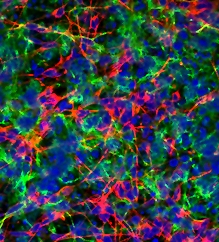More and more research groups are working with human nerve cells in the petri dish with the aim to investigate early development stages of human brain or neurodegenerative processes. However, nerve cells alone are not sufficient to realistically construct human brain tissue. The brain´s basic cell types are both neurons (main and interneurons) and glial cells, which differ in astrocytes and oligodendrocytes. In addition, microglial cells are part of the brain as a component of the immune system.
Astrocytes - an important cell type in the brain
Around 80 percent of the brain cells are astrocytes. They are located at the synapses of neurons. When neurotransmitters such as glutamate or adenosine triphosphate (ATP) are released at this region, these substances bind to the astrocytes´ membrane effecting an influx of calcium into the cell. The cell forward this influx to other astrocytes. Astrocytes may also release Glutamate and ATP to distribute in this manner contributing to the information flow. They functions like a moderator during information exchange of the nerve cell tissue, but play also a role in remodeling of nerve cell network (keyword: neuroplasticity) and are involved in formation of new synapses. The issue is more complicated by the fact that there are different properties of astrocytes in different brain regions. Therefore the ability to breed mature astrocytes in a nerve cell culture is of great importance.
Coculture of astrocytes: neurons (stained in red), astrocytes (green) and nuclei (in blue).
Foto: Marcel Leist, chair of in vitro toxicology and biomedicine, University of Konstanz.
High consumption of animals in biomedical research
In Europe about 12 million animals are applied per year, three quarters are used in biomedical research, reported Prof. Leist 2015 during his animal welfare research awarding ceremony in 2015 (1). Together with his team have he was successful in establishing of a three-dimensional cocultur model consting of human neurons and astrocytes. It allows scientists to study neurodegenerative diseases and test pharmaceutical compounds for its treatment. The bad thing: The current state of development made it still necessary to combine human neurons with astrocytes from mice in cocultures. The reason was that there was not a practicable method to successfully breed human astrocytes in an practicable time. "There are many neuron and even astrocyte protocols. We have checked so far all published information for culturing astrocytes. However, they are not really applicable" the scientist said.
Mini-Brains recapitulate early brain development
The mini brain constructions of the Institute of Molecular Biotechnology GmbH in Vienna or those from the Center for Alternatives to Animals Testing (CAAT) in Baltimore are developed from induced pluripotent stem cells. They already display all major cell types as different types of nerve cells, astrocytes, and oligodendrocytes (1). However, these highly regarded in vitro models recapitulate an early stage of human brain development. Additionally they can only be further developed to a certain stage.
New cocultures model for research on neurodegenerative diseases
Using a financial funding from the State budget of Baden-Württemberg, Prof. Leist, owner of the Doerenkamp-Zbinden Chair of in vitro Toxicology and Biomedicine Konstanz will develop and establish human astrocytes from induced pluripotent stem cells. In co-culture with other cell types they are used in basic research to study neurodegenerative diseases, for example the pathological disturbance of an interaction between neurons and astrocytes. They can also be used in applied medical research and drug development. In future a cell source become available, which could also made available to other researchers in this field. The functionality of teh new model well be proven by, for example, an examinination of the role of astrocytes in synaptogenesis, the study of astrocyte interaction with microglia during inflammation and metabolic studies. The team of scientists also want to characterize various types of astrocytes.
There are exciting findings expected in future.
The funding of the State of Baden-Württemberg is euros 158,000 for the next three years.
Further information:
http://mlr.baden-wuerttemberg.de/de/unser-service/presse-und-oeffentlichkeitsarbeit/pressemitteilung/pid/minister-hauk-mdl-zum-wohl-der-tiere-muessen-stetig-verfahren-entwickelt-werden-um-tierversuche/
http://www.invitrojobs.com/
http://www.invitrojobs.com/index.php/
http://www.networkglia.eu/astrozyten
Also interesting:
Susanne Donner (o.j.): Der Mensch denkt, die Glia lenkt. http://www.networkglia.eu/sites/networkglia.eu/files/docs/Glia_fuer_Einsteiger.pdf




 Dr. rer. nat.
Dr. rer. nat. Menschen für Tierrechte - Tierversuchsgegner Rheinland-Pfalz e.V.
Menschen für Tierrechte - Tierversuchsgegner Rheinland-Pfalz e.V.